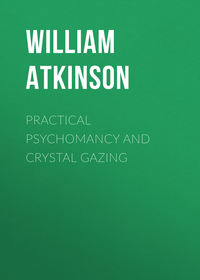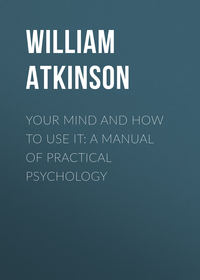
Practical Mind-Reading
Practice this exercise and experiment, in different rooms, and with different Transmitters, until you can go readily to the selected corner. Do not be discouraged, but remember that "practice makes perfect," and that like any other thing the art must be learned by patient practice and repetition. It is like learning to play the violin – skating – dancing, or anything else. If after a number of trials you begin to feel tired, stop practicing and adjourn the experiments until the next day. Do not unduly strain yourself, or tire out your mind. When the next day comes you will be surprised at the added proficiency you have gained.
You may vary the above method by holding the Transmitter's hand out at arm's length, instead of holding it up to your head. Some find one plan more effective, and others prefer the second. The principle is the same in both cases, so adopt either plan, or any variation thereof, providing it proves effective.
PRACTICE EXERCISE I. FINDING LOCATIONSAfter you have grown proficient in locating the corners of rooms, you may have the Transmitter select other parts of the room, such as doors, mantels, windows, alcoves, projections, etc. Try a number of these selected locations in turn, gaining a variety of experiences which will prove valuable later on. In all of these experiments the Transmitter must guard you from running into obstacles, furniture, etc., by telling you to avoid them, guiding you past them, and in other proper ways prevent you from bruising yourself or breaking or upsetting things. You must impress this upon his mind, and then you should give yourself into his care with the utmost confidence, giving yourself no further concern about these things, and keeping your mind as passive as possible. Don't allow your mind to be distracted by outside things – attend to the matter of the experiment in which you are engaged.
PRACTICE EXERCISE II. FINDING LARGE OBJECTSThe next step should be the selecting and finding of large objects in the room, such as chairs, tables, etc. Proceed as in the previous exercises. Do not neglect this exercise in your desire to do more wonderful things, for you need just this training. You will realize the importance of these exercises after you begin to appear before friends and evening companies, etc., when you will be called upon to find hidden objects, selected articles secreted under tables, on persons, on furniture, etc. If you can find selected chairs you will be able to more readily find persons seated on chairs. Continue this exercise until you can readily find any and every piece of furniture in a room, and the other large objects in a room as well, when they are thought of by the Transmitter.
PRACTICE EXERCISE III. FINDING SMALL OBJECTSAfter mastering the above exercise have the Transmitter select some small articles, such as a book, vase, ornament, etc., on a table, mantel-piece, etc. Proceed as before, varying the objects and places, endeavoring to get as wide a range of experiences as possible along the line of Mind Reading of this kind.
PRACTICE EXERCISE IV. FINDING HIDDEN ARTICLESAfter you have mastered the last mentioned exercise, have the Transmitter select a small object, such as a watch-key, match-safe, etc., and secrete it in some part of the room, you remaining out of the room until the article is selected and hidden. Proceed as before, until you find the secreted object. Your Transmitter should endeavor to give you a great variety in this exercise, in order to properly train you for the public demonstrations before companies, etc. Have him place a key in a book, under a rug, back of a picture, and in similar difficult places. Let him exercise his ingenuity in finding strange places in which to hide the object. In the experiments in finding the hidden objects he must train himself to give you the mental messages "up"; "down"; "to the right"; "to the left," etc., just as he did his old message or impulse "this way." And you must train yourself to receive them. This training will be of the greatest possible benefit to you when you are called upon later to find objects hidden in people's pockets, etc.
GENERAL REMARKS ON PRACTICEThe above exercises will train the student to receive and act upon the mental commands or messages of the Transmitter, under a great variety of circumstances and conditions. Many of the most successful public "Mind Readers" started out in public work with far less careful and thorough training. But there are now still greater degrees of proficiency possible. The student will find in succeeding chapters a number of interesting and startling feats and experiments which are intended for parlor audiences, etc., but which may be most profitably practiced previously with the aid of a good friendly Transmitter, in order that the Performer may familiarize himself with the details of the experiment, and thus be more at his ease when he demonstrates it in public. Then other new experiments and feats will suggest themselves from time to time, to the intelligent student which, likewise, should be practiced previous to a public demonstration.
In finding a hidden object, the first thing to do is to get an idea of the direction. Then the general location of the hiding place; and so on, from general impressions to detailed ones, until at last the fingers close upon the object itself. The Transmitter will be greatly relieved when the object is finally found, and the relaxing of his mental tension may be distinctly felt, and then you will know that your search is at an end.
PREPARING FOR PUBLIC WORKBefore taking you on with the work before an audience, we must urge upon you to prepare yourself thoroughly by means of the above mentioned exercises. The great tendency among students is to hurry through to the public work, and skipping the exercises as much as possible. This is all wrong. You will never be a thoroughly good demonstrator of anything in life, until you master the rudiments, and by practice familiarize yourself thoroughly with the details of the work. And Mind Reading is no exception. It is true that after a few exercises you may be able to give a fair demonstration before an audience, but you will never get further than "fair" without careful practice. And therefore we urge you to have patience and perseverance, and to stick to the exercise until you become a Master of Mind Reading, when you need fear no audience whatsoever, and will be able to give a demonstration that will be a great credit to both yourself and to us, your instructors.
And, now for your work before an audience, remembering, always that the feats and experiments that we shall mention, should be practiced by you privately, with the aid of a friendly Transmitter, before you reproduce them in public. In the case of feats, in which the audience is a party to the experiment, such as the finding of a scarf-pin on a member of the audience, you may practice with a dummy audience, that is with an imaginary audience consisting of chairs, etc., until you familiarize yourself with the details of the feat.
LESSON V.
SIMPLE DEMONSTRATIONS
In beginning a public demonstration, it will be well for you to give a short preliminary talk to the audience, somewhat along the following lines:
OPENING TALK"Ladies and Gentlemen, with your assistance I shall endeavor to give you a demonstration of practical Mind Reading, beginning with some simple feats, and then proceeding gradually to more complicated demonstrations. In these demonstrations, I must have your co-operation, for the success of the experiments depends as much upon you as upon myself. In the first place, I must ask that you refrain from conversation, laughter, etc., while I am demonstrating, for these things distract the mind of the Transmitter and prevent him from concentrating his Mind and Will upon mine; and also prevent me from maintaining that Passive Mental State which is essential to the success of the experiments. I trust that you will help me in this way. I also ask that during the experiments, you will all concentrate your Mind and Will upon me, and help me in the work. In order to obtain the best results all Mind Readers prefer that their audiences concentrate their Wills upon the work, with the purpose of mentally willing that the demonstrator be successful. In fact the success of the experiments depend very materially upon the Willing exerted by the audience. If you Will in my favor, I shall be successful; if you Will that I shall fail, I shall feel the effect. Therefore, kindly give me your aid. I ask you to blindfold me and take such other means to prevent unfair methods and practices, as your judgment may dictate. I am now ready to proceed with the tests."
CHOOSING THE TRANSMITTERThen have the audience select a committee to blindfold you and remain outside of the room with you, while the remainder of the audience select the object that you are to find, etc. When you return to the room, select someone to act as Transmitter. If possible get someone with whom you have previously practiced, and established rapport conditions. This will aid you very materially, of course. If this is not possible, select someone of the audience that is in harmony with you, and who will have a strong enough will to give you the vibrations. Sometimes women are very good at this work, as they get very much in earnest when interested, and therefore Will intently. If your first Transmitter is not satisfactory, test another, and so on until you get a good one. You may change Transmitters during the evening, if you prefer; in fact this is a good plan, if you are an adept, for it shows the audience that there is no collusion.
INSTRUCTING THE TRANSMITTERYou should instruct the Transmitter, along the lines indicated in a previous chapter, i.e. that he must hold the thought of direction, fix his eyes on the chosen spot and then concentrate his will upon it, and that your success will depend materially upon his ability to concentrate his Mind and Will upon the task. You should explain to him that you receive your impulses through his thought-waves or vibrations, and that the stronger these are, the better you will succeed. Make this plain to him. When the Transmitter fails to concentrate his Will, you will know it at once, and should call his attention to it, saying "Concentrate, concentrate now – harder – use your Will," or words to that effect. You should impress upon the Transmitter that it is the strength of his Will that produces the mental vibrations that give you the impressions.
BEGINNING THE TESTThen, take the hand of the Transmitter, in the manner already described in previous lesson, placing it to your forehead, or else holding it up high in front of you. Then begin a wavering motion, or direction, preferably describing a circle, slowly. In this meaningless wavering motion remain perfectly passive awaiting impressions. Soon you will begin to feel a mental resistance to certain directions, and a mental willingness that you move in another direction. Then move along the line of the least mental resistance. In some cases you will receive a strong mental urge, pull, or push, in the direction of the selected spot. Here is where your practice comes in, for in your practice experiments you have acquired the art of recognizing these impressions as they come to you, in their different forms, and so are prepared to yield to them and move accordingly. It is impossible to describe in writing just how these impressions come, and feel like, for actual experience is necessary before you will know just what is meant. But once you have accustomed yourself to receive and recognize the impressions, the rest is all a matter of practice and development.
And now for the demonstrations themselves. You should begin with the simplest feats, and then work up gradually to the more complicated and difficult ones. This plan will build up your own powers, and will develop the Transmitter's. We herewith give a number of interesting feats and demonstrations, explaining the details of each. Of course, the general directions we have given regarding the receiving of impressions, etc., will apply to all of these feats, for the principle underlying them all is the same, precisely.
FINDING A LOCATIONDEMONSTRATION I. Begin by having the audience select a part in the room, which may be easily reached by you. Then proceed as directed, until you feel that you have reached the right place, or location.
FINDING A PERSONDEMONSTRATION II. Have the audience select a person, one of their number. Find the general location of the person. Then standing still, reach out your right hand, and begin "feeling about." You will find that as your hand moves away from the right person you will feel a drawing back impression, whereas when you reach toward the person you will receive an urging forward impression. A little practice will soon enable you to distinguish these mental impressions. Then place your hand on the person who seems to be the centre of the impressions. If this is the wrong person, you will receive a mental impression of "Wrong"; in which case you must start up the moving your hand to and fro, and around, until you feel the urge impression, when you should place your hand on the person immediately in front of you. When you reach the right person, you will receive an unmistakable impression and mental message of "All Right," followed by a lessening of the Will tension, and you will know that you have succeeded. You should practice this in private before attempting public demonstration.
FINDING A SMALL OBJECTDEMONSTRATION III. Have the audience select some small object in plain sight in the room. Then find it in the manner described of above in the case of the selected person. The rule is identically the same. But there are some other details to be observed, in the matter of "up or down," for the object may be higher than your shoulder or lower, in which case you will have to either reach up or down. In this reaching up or down, follow the same general rule as given. When you reach the right location, you will feel an impression of "not yet finished" from the mind of the Transmitter. Then reach up slowly. If this is right you will receive a corresponding impression, and may go on to centre the object. But if it is not right, you will receive a mental urge downward, which you should follow. The rule always is to follow the line of the least mental resistance. You will always receive the resistance when you are not succeeding, and will always receive the lack of resistance when you are succeeding. Learn to focus these impressions until they centre positively and constantly on the same spot – then you have succeeded, for there will be your object right under your hand.
FINDING A BOOKDEMONSTRATION IV. Have the audience select a book on the shelves of a book case, and then find it in the manner just related. The two feats are precisely the same, although the latter will appear more startling to the observer.
THE FLORAL TRIBUTEDEMONSTRATION V. This test is known as "The Floral Tribute." It is performed by having a bouquet of flowers on the table. Then select some young man in the audience, and let him pick out some young woman in the audience whom he wishes to have the flowers. You must retire from the room, of course, while he selects the young lady and mentions her name and position to the audience. Then returning to the room, pick up the bouquet, and taking the hand of your Transmitter, find the young lady and present her with the flowers. Of course this feat is merely a fancy rendition of the simple feat of finding the person thought of, and is performed in the same way. (Study the directions for Demonstration II, and apply in the present case, with appropriate variations.)
THE REUNITED COUPLEDEMONSTRATION VI. This test is known as "The Reunited Couple." It is performed by having the audience select two persons, a young man and a young woman, and stand them up in front of the room, like a couple about to be married. Then they should have a third person, a man, selected and stood before them as the parson who will tie the knot. The three persons should then take their seats, and when you enter the room, and take the hand of your Transmitter, you must first find "the Parson"; then "the Groom"; and then "the Bride," and arrange them in their proper positions. This is a highly effective test, and invariably brings hearty applause, and the hunt affords much merriment to the audience. But, as you will see readily, it is but a variation of Demonstration II.
THE HIDDEN JEWELRYDEMONSTRATION VII. Have the audience select some small article, like a scarf-pin, ring, etc., and hide it on the person of some one of the audience. Then you are to find it. This demonstration combines the features of Demonstration II, and Demonstration III, that is you have first to find the person, as described in Demonstration II, and then the object which is practically a variation of Demonstration III. Study the details of Demonstration III, and practice the present demonstration in private before trying it in public.
THE DISCOVERED COURSEDEMONSTRATION VIII. Have a member of the audience walk around the room, following a prescribed course selected by the audience. Have your Transmitter memorize the course accurately, and then you must walk over the same course when you return to the room. This is effective, but is merely a variation of the "Finding the Corner" demonstration.
REPLACING THE PINDEMONSTRATION IX. This is called "Replacing the Pin," and is very effective when properly performed. Have a member of the audience take a pin and insert it in the wall in a spot plainly visible to the audience, not too high up, however – about on the level of your shoulder is best. Then have him withdraw the pin and hide it somewhere in the room. Then when you return to the room, and take the Transmitter's hand, you should first find the pin, (in the manner heretofore described) and then find the place where it had been stuck; then circling your hand around in narrowing circles until you feel the proper impression push the pin home in the spot in which it formerly was driven. This final effort is really merely a modification of "finding the spot," and with a little practice may be easily performed.
THE THEFT DETECTEDDEMONSTRATION X. This feat is called "The Theft." Have one of the audience play "the thief," and steal an article of jewelry, or similar small object from a second person called "the victim." Then the thief should hide his spoil in a safe place about the room. Returning you first find the thief; then the hidden article; then the person, according to the methods already given. This is a very effective feat, but is merely a combination of "Finding the Person," and "Finding an Object."
THE RECONSTRUCTED TABLEAUDEMONSTRATION XI. This feat is known as the "Reconstructed Tableau." It is performed by having several of the audience form a simple tableau group, and then retire to their seats. Returning to the room you are to find each person; lead him or her to the former spot; then reconstruct the group. This is somewhat difficult, but not nearly so much so as you might suppose. A little private practice will enable you to perform it with ease.
THE MURDER AND THE DETECTIVEDEMONSTRATION XII. This test is known as the "Murder and the Detective," and is very spectacular and sensational, and is accordingly one that is in great favor with the public performers. It is performed as follows: The audience selects one man to act as the "murderer"; another to act as "the victim"; and also some object to act as the dagger; and lastly a place in which the body is to be concealed. Then the "murderer" picks up the "dagger," and "kills" his "victim," afterward concealing the body in some part of the room (usually sitting in a chair) and the "dagger" in another place. Then when you return to the room you first find the "body"; then the "wound"; then the "dagger," and then the "murderer." This is usually announced as a wonderful piece of "telepathic detective work," and is extremely effective, and may be reserved as the "principal effect" of your series of demonstrations.
You will notice that the feat is merely an elaborate combination of the simpler feats of "Finding the Person," "Finding the Object," etc.
THE RETURNED HATSDEMONSTRATION XIII. Have the hats of a number of men in the audience placed on a table or other place, and then returning to the room, blindfolded of course, you pick up the hats, one by one, and place them upon the heads of their proper owners, who are seated in different parts of the room. This is a simple feat although very effective. It is, of course, merely a variation of the feat of "finding the person." There is one point, however, that must be remembered in this feat, and that is that the Transmitter should know just whose hat is held in your hand – just who the owner of that particular hat is and where he is sitting or standing. Otherwise he cannot send you the mental impulses which will enable you to find the owner. It will be well for the Transmitter to hold the hat so that it can be seen by the audience, requesting the owner to rise in his seat so as to indicate his whereabouts – your back being turned to the audience while this is being done in order to avoid suspicion of your "peeping," etc.
THE LADY AND THE RINGDEMONSTRATION XIV. This feat is performed by having a lady in the audience loan the Transmitter her ring. When you return to the room, you find the lady and replace the ring upon the finger from which she took it. The Transmitter must remember the lady, and the particular finger, of course – the rest is simply a combination of the "finding the person" and "finding the spot" feats. It is very effective, if neatly performed.
GENERAL ADVICEI. We have given you a great variety of Demonstrations or Feats, but you must not attempt to produce all of them at an evening's entertainment. It will take some time to perform a few of them effectively, and impressively, and you should avoid any attempt to hurry through the feats. Nor should you spoil your good impression by cheapening the demonstrations in the direction of performing too many at one sitting.
II. Neither should you tire or fatigue yourself by too many feats. When your mind or body are tired, you do yourself an injury to perform these demonstrations, and besides, you cannot obtain the best results while fatigued. You should rest a little while after each feat, before attempting another one.
III. When the entertainment, or exercises are over, you should take a few strong deep breaths, swing your arm around a little to promote the circulation, and relieve the nervous tension. You may feel a little "dazed" at first after performing a few feats, but will soon learn to throw off the passive condition, and engage in the laughing conversation that will follow the entertainment. Do not take yourself too seriously and remember that laughter and a little boyish or girlish spirits is a wonderful tonic.
IV. Do not become impatient if you do not progress as rapidly as you would desire. You are practically developing a sixth sense, and are like a baby learning to walk – it takes time, but practice will surely bring you success. Take things calmly. The feats that will be possible for you to perform, even from the start will be wonderful enough, without any necessity for your complaining about your slowness in learning to perform the more complicated ones.
ABOUT TRANSMITTERSI. If your Transmitter does not do his work properly, and you feel that he is not Concentrating properly, or using his Will effectively, do not hesitate to change him. You need not offend him, for you may say simply that the rapport conditions are not fully developed between you, and that these things sometimes happen, etc. Your new Transmitter will feel anxious to do better than his predecessor, and will be most likely to Concentrate and Will to the best of his ability.
II. The Transmitter should be in earnest, and no levity or trifling should be permitted. If you have the selection, pick out some earnest person, and avoid the trifling, feather-brained class.
III. If your Transmitter does not seem to be Concentrating properly, you should speak to him firmly, but kindly, about it. Say to him: "Please concentrate your Mind, and Will earnestly – fix your Mind on the right Spot – make a determined Mental Effort that I move in the right direction – it is your Mind and Will that gives me the impression, remember – it all depends upon you," etc. This will often have the effect of bracing him up to renewed mental activity, and you will notice the improvement at once.









